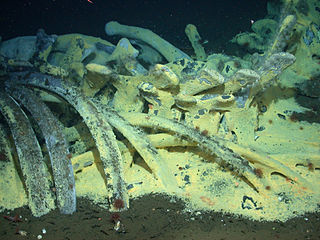
A whale fall occurs when the carcass of a whale has fallen onto the ocean floor at a depth greater than 1,000 m (3,300 ft), in the bathyal or abyssal zones. On the sea floor, these carcasses can create complex localized ecosystems that supply sustenance to deep-sea organisms for decades. This is unlike in shallower waters, where a whale carcass will be consumed by scavengers over a relatively short period of time. Whale falls were first observed in the late 1970s with the development of deep-sea robotic exploration. Since then, several natural and experimental whale falls have been monitored through the use of observations from submersibles and remotely operated underwater vehicles (ROVs) in order to understand patterns of ecological succession on the deep seafloor.
Streptomonospora amylolytica is a species of bacterium. Its type strain is YIM 91353T.
Neptunomonas naphthovorans is a species of bacteria. It is notable for utilising naphthalene as a sole carbon and energy source. Its type strain is NAG-2N-126.
Neptunomonas concharum is a species of bacteria. It is Gram-negative, facultatively anaerobic, motile and rod-shaped, its type strain being LHW37T. This species was first isolated from a dead ark clam, hence the specific epithet "concharum", meaning "of the shells".
Neptunomonas qingdaonensis is a species of bacteria. It is Gram-negative, motile, aerobic, oxidase- and catalase-positive and rod-shaped. The type strain is P10-2-4(T).
Neptunomonas antarctica is a species of bacteria. It is Gram-negative, motile, facultatively aerobic and oxidase- and catalase-positive. The type strain is S3-22T.
Flavobacterium frigidarium is a bacterium. It is an aerobic, psychrophilic, xylanolytic and laminarinolytic bacterium from Antarctica. It is gram-negative, non-motile and yellow-pigmented. Its type strain is A2iT.
Luteimonas lutimaris is yellow-pigmented, Gram-negative, strictly aerobic bacterium. Its type strain is G3(T).
Thermotoga petrophila is a hyperthermophilic, anaerobic, non-spore-forming, rod-shaped fermentative heterotroph, with type strain RKU-1T.
Microlunatus lucidus is a Gram-positive, non-motile, aerobic actinomycete. The type strain is FA2T.
Microlunatus okinawensis is a Gram-positive, non-motile, aerobic actinomycete. The type strain is FB1T.
Microlunatus sagamiharensis is a Gram-positive, non-motile, aerobic actinomycete. The type strain is FB2T.
Gracilibacillus ureilyticus is a Gram-positive, halotolerant, neutrophilic, rod-shaped bacterium. MF38T is its type strain.
Arthrobacter roseus is a species of red-pigmented psychrophilic bacteria first isolated from a cyanobacterial mat. Its type strain is CMS 90r(T).
Cryobacterium psychrophilum is the type species of the bacterial genus Cryobacterium. It is an obligately psychrophilic, Gram-positive irregular rod-shaped actinomycete, with type strain JCM 1463.
Saccharibacter floricola is an osmophilic acetic acid bacterium first isolated from pollen. It is Gram-negative, aerobic and rod-shaped, with type strain S-877T. It is the type species of its genus.
Aquimarina macrocephali is a Gram-negative, strictly aerobic and rod-shaped bacterium from the genus of Aquimarina which has been isolated from sediments near a whale carcasses near Kagoshima on Japan.
Neptunomonas is an anaerobic and rod-shaped genus from the family of Oceanospirillaceae.
Amphritea balenae is a Gram-negative, rod-shaped, non-spore-forming and motile bacterium from the genus of Amphritea which has been isolated from sediments near a sperm whale carcasses from Kagoshima on Japan.
Amphritea japonica is a Gram-negative, rod-shaped, non-spore-forming and motile bacterium from the genus of Amphritea which has been isolated from sediments near a sperm whale carcasses from Kagoshima on Japan.
